|
THIS IS A REFERENCE LISTING OF ANCIENT JUDAEAN COIN TYPES THAT WE HAVE HANDLED IN THE PAST, NOT A LISTING OF COINS OFFERED FOR SALE.
To find a listing of the coins that we currently have for sale, please see our sales catalogue of coinage of the Ancient Greek world.
Both coins issued under Jewish authority, and coins relating to Judaea but issued by other authorities are included on this page. This is by no means a comprehensive listing, including only a fraction of types related to Judaea that exist. Over time, many more coin types will be listed here.

Persian Rule in Judaea
In the early sixth century BC Judaea was ruled by the Persian Empire, but many of the Jewish people were living as exiles in Babylon. In 538 BC, the Persian King Cyrus allowed these people to move to Judaea where they lived under Persian rule until Alexander the Great conquered the region in 332 BC.
The principle coinage used during this period would probably have been the royal Persian silver siglos and gold daric, but we see no evidence that any were minted in Judaea. There is a series of very small silver coins inscribed "Yehud" (the Persian name for Judaea) which appear to have been struck locally with Persian consent.
 LYDIA, 450-330 BC, silver siglos, S-4682. Obverse: running bearded archer (probably the Persian king) holding a bow in front and with a spear over his shoulder. Reverse: oblong punch. The bow and the back foot of the archer are off the flan, 14.5 x 17.5 mm. This this example does not have any bankers stamps on it, but it would not be unusual for find some on these. Generally, the designs are larger than the blanks, and examples with full images are scarce. LYDIA, 450-330 BC, silver siglos, S-4682. Obverse: running bearded archer (probably the Persian king) holding a bow in front and with a spear over his shoulder. Reverse: oblong punch. The bow and the back foot of the archer are off the flan, 14.5 x 17.5 mm. This this example does not have any bankers stamps on it, but it would not be unusual for find some on these. Generally, the designs are larger than the blanks, and examples with full images are scarce.
 LYDIA, 450-330 BC, silver siglos, S-4683. Obverse: A bearded archer (probably the Persian king) kneeling right holding a dagger behind him, and a bow in front of him. Reverse: oblong punch. There are no bankers' marks on the obverse, but three small test punches (not bankers' marks) on the reverse of this example, but bankers marks are common on these. 16.5 x 13. Generally, the designs are larger than the blanks, and examples with full images are scarce. LYDIA, 450-330 BC, silver siglos, S-4683. Obverse: A bearded archer (probably the Persian king) kneeling right holding a dagger behind him, and a bow in front of him. Reverse: oblong punch. There are no bankers' marks on the obverse, but three small test punches (not bankers' marks) on the reverse of this example, but bankers marks are common on these. 16.5 x 13. Generally, the designs are larger than the blanks, and examples with full images are scarce.

Macedonian Rule in Judaea
Alexander the Great annexed Judaea into the Macedonian Kingdom in 332 BC. Upon his death general Ptolemy was appointed governor of the region and ruled under the name of the Macedonian Kingdom until 305 BC, when he declared himself king and established the Ptolemaic Kingdom.
During the later years of Alexander's life, and for many years there after, coins based on the Macedonian issues of Alexander were struck at several mints in the region, and probably would have circulated freely in Judaea.
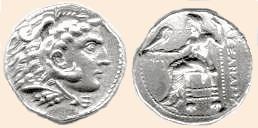 ALEXANDER THE GREAT, 336-323 BC, silver tetradrachm. Obverse: youthful head of Herakles right, wearing a lion's skin headdress. While the obverse is officially Herakles, the features are very similar to those of Alexander. Reverse: Zeus seated left, holding an eagle in his right hand, a scepter in his left hand and with the name of Alexander behind. Below Zeus' arm is a Phoenician inscription indicating that this coin was struck at Ake mint in the Holy Land, in year 25 of the Ake era (322/21 BC) one year after the death of Alexander. Well-centered. The actual size is 27 mm. The weight standard for these is about 17.2 grams. ALEXANDER THE GREAT, 336-323 BC, silver tetradrachm. Obverse: youthful head of Herakles right, wearing a lion's skin headdress. While the obverse is officially Herakles, the features are very similar to those of Alexander. Reverse: Zeus seated left, holding an eagle in his right hand, a scepter in his left hand and with the name of Alexander behind. Below Zeus' arm is a Phoenician inscription indicating that this coin was struck at Ake mint in the Holy Land, in year 25 of the Ake era (322/21 BC) one year after the death of Alexander. Well-centered. The actual size is 27 mm. The weight standard for these is about 17.2 grams.

Ptolemaic Rule in Judaea
From 305 BC, down to 198 BC, Judaea was ruled by the Ptolemies. Coinage of the early Ptolemaic Kingdom would have been circulating in Judaea at this time, and, while none appear to have been minted in Jerusalem, tetradrachms of Ptolemy I to Ptolemy V can be found with mint marks for the surrounding towns of Sidon, Tyre, Ptolemais, Joppa and Gaza.
There is also one type of "Yehud" coins (see above under the Persian period), which was struck at this time.
 YEHUD COINAGE, early 3rd century BC, 5.8 mm silver, Hendin #5. Obverse: Ptolemaic style bust right. Reverse: Ptolemaic style eagle with wings spread backwards, with an ancient Hebrew inscription to the left. Hendin dates this type to the Persian period, prior to 332 BC, but the type seems to be taken from the standard coins of the early Ptolemaic Kingdom, of a type first minted in about 305 BC. It is reasonable to assume that this coin was minted between 305 and 198 BC. We have provided an illustration of the coin, but due to the small size it is impossible to get a good image with our equipment. The head side is hard to see, but the eagle is clear. Only traces of the Hebrew inscription are visible as most of the characters are off the flan. These coins are rare and generally do not come much nicer. There is some question about the authenticity of most of these coins, but this example is definitely genuine as it has never been cleaned and is covered with a layer of purple silver chloride (hornsilver) which would be almost impossible to fake. (It might improve with a professional cleaning, but would then be difficult to authenticate). This is a rare and important Jewish coin and probably the only type that can reasonably be assigned to the period of Ptolemaic rule of Judaea. YEHUD COINAGE, early 3rd century BC, 5.8 mm silver, Hendin #5. Obverse: Ptolemaic style bust right. Reverse: Ptolemaic style eagle with wings spread backwards, with an ancient Hebrew inscription to the left. Hendin dates this type to the Persian period, prior to 332 BC, but the type seems to be taken from the standard coins of the early Ptolemaic Kingdom, of a type first minted in about 305 BC. It is reasonable to assume that this coin was minted between 305 and 198 BC. We have provided an illustration of the coin, but due to the small size it is impossible to get a good image with our equipment. The head side is hard to see, but the eagle is clear. Only traces of the Hebrew inscription are visible as most of the characters are off the flan. These coins are rare and generally do not come much nicer. There is some question about the authenticity of most of these coins, but this example is definitely genuine as it has never been cleaned and is covered with a layer of purple silver chloride (hornsilver) which would be almost impossible to fake. (It might improve with a professional cleaning, but would then be difficult to authenticate). This is a rare and important Jewish coin and probably the only type that can reasonably be assigned to the period of Ptolemaic rule of Judaea.
 ALEXANDER THE GREAT, 336-323 BC, posthumous issue silver tetradrachm. Price-3540. This example was struck at the Phonecian mint of Tyre, ca. 305-290 BC. Obverse: bust of Heracles right, wearing the lion's skin. Reverse: Zeus seated left on a backless throne, holding an eagle in his outstretched hand, with Greek monogram by his knee (the same monogram as on Price-3540), another Greek monogram (a type not recorded by Price) below the throne, with a Greek inscription naming Alexander behind. The central images are very strong, and the style is well above average. 27 mm, 17.16 grams. ALEXANDER THE GREAT, 336-323 BC, posthumous issue silver tetradrachm. Price-3540. This example was struck at the Phonecian mint of Tyre, ca. 305-290 BC. Obverse: bust of Heracles right, wearing the lion's skin. Reverse: Zeus seated left on a backless throne, holding an eagle in his outstretched hand, with Greek monogram by his knee (the same monogram as on Price-3540), another Greek monogram (a type not recorded by Price) below the throne, with a Greek inscription naming Alexander behind. The central images are very strong, and the style is well above average. 27 mm, 17.16 grams.
Having been struck at the mint of Tyre in Phonecia, between 305 and 290 BC, this type could well have circulated in the area of Jerusalem during the period of Ptolemaic Rule in Judaea.

Seleukid Rule in Judaea
Judaea came under the control of the Seleukid kingdom in 198 BC. When the Seleukids suffered a major defeat at the hands of the Romans in 188 BC, their power in the region diminished and the Jewish people began to exert some independence, culminating in the establishment of the Hasmonaean dynasty later in the century. We have not been able to identify any coins issued under Jewish authority during this period, but the following coin was probably minted in Jerusalem for the use of the Jewish people.
Antiochos VI, 138-127 BC, 14 mm. bronze. S-7101. Obverse: A lily. Reverse: An anchor flanked by legends naming Antiochos. This type was probably minted in Jerusalem ca 132 BC when Antiochos captured Jerusalem while campaigning in Judaea at the time of Simon Maccabee. While not minted by Jewish authority, this type was used in Judaea and was the prototype for the first issues of Alexander Jannaeus, about 30 years later.
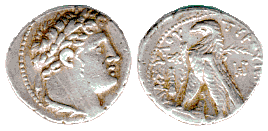 PHOENICIA, TYRE, Silver tetradrachm, S-5918-20 with Phoenician date year 27 (ca 99 BC). Obverse: Head of Melqarth facing right. Reverse: eagle standing left, a club to the left with the Phoenican date year 27 (ca 99 BC) below the arm. This is a bold and attractive, well-centered coin. There is a die break on the cheek which is not visible on the image. Actual size is 30.5 mm. and the weight is 14.25 grams. SHEKELS OF TYRE ARE THE MOST LIKELY CANDIDATES FOR THE 30 PIECES OF SILVER PAID TO JUDAS. PHOENICIA, TYRE, Silver tetradrachm, S-5918-20 with Phoenician date year 27 (ca 99 BC). Obverse: Head of Melqarth facing right. Reverse: eagle standing left, a club to the left with the Phoenican date year 27 (ca 99 BC) below the arm. This is a bold and attractive, well-centered coin. There is a die break on the cheek which is not visible on the image. Actual size is 30.5 mm. and the weight is 14.25 grams. SHEKELS OF TYRE ARE THE MOST LIKELY CANDIDATES FOR THE 30 PIECES OF SILVER PAID TO JUDAS.
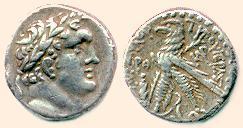 City of Tyre, didrachm (or 1/2 shekel). S-5921 variety. Obverse: bust of Melqart right. Reverse: Eagle standing left, with a monogram of Greek letters to the right and the date mark "PA" (year 101 = 27/6 BC) to the left. 6.4 grams, 19 mm. Note that the style of this issue is very different from the full shekel listed above. This difference is typical for the time periods in which the two coins were struck. City of Tyre, didrachm (or 1/2 shekel). S-5921 variety. Obverse: bust of Melqart right. Reverse: Eagle standing left, with a monogram of Greek letters to the right and the date mark "PA" (year 101 = 27/6 BC) to the left. 6.4 grams, 19 mm. Note that the style of this issue is very different from the full shekel listed above. This difference is typical for the time periods in which the two coins were struck.
This is the half unit famous Shekel of Tyre that is believe to have been the type of coin used to pay Judas his 30 pieces of silver. This denomination is in it self an important biblical reference type as it the the denomination used in ancient Judaea to pay the temple tax which is also mentioned in the bible.

Hasmonaean Dynasty
Alexander Jannaeus, 103-76 BC
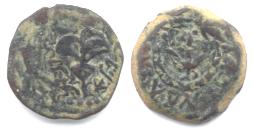
click for enlargement |
Bronze Prutah. S-6086. Obverse: Lily with a Hebrew legend around. Reverse: An anchor within a circle with a Greek inscription naming Alexander. As is normal for these coins, only parts of the inscriptions are on the flan. The example illustrated is 14.8 mm. This type closely resembled the Seleukid issues of Antiochos VII (S-7101), which are thought to have been minted in Jerusalem ca 132 BC. It is likely these are one of the earliest issues of the Hasmonaean Dynasty. |
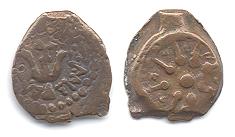 Bronze prutah, S-6087. Obverse: Anchor with a Greek legend translating to "KING ALEXANDER" around. Reverse: Diadem within which is an eight-rayed star, with the Hebrew legend translating to "YEHONATAN THE KING' between the rays of the star. These coins are usually very crude and off-center with little of the legend visible, and lightly corroded, but recently there has been a large hoard of very nice examples on the market at fairly reasonable prices. Bronze prutah, S-6087. Obverse: Anchor with a Greek legend translating to "KING ALEXANDER" around. Reverse: Diadem within which is an eight-rayed star, with the Hebrew legend translating to "YEHONATAN THE KING' between the rays of the star. These coins are usually very crude and off-center with little of the legend visible, and lightly corroded, but recently there has been a large hoard of very nice examples on the market at fairly reasonable prices.
Most references describe the reverse of these coins as a wheel with eight spokes, but Ya'akov Meshore, in ANCIENT JEWISH COINAGE, Volume 1, page 61, clearly demonstrates that this is really an eight-pointed star within a diadem. He goes on to point out that the diadem is a Hellenistic symbol of Kingship, and that the star may derive from the Song of Balaam which states "There shall come a star out of Jacob and a scepter shall rise out of Israel" (Num. 24:17), so the iconology makes perfect sense for this coin.
 Bronze prutah, S-6088 variety. Obverse: Anchor with a Greek legend translating to "KING ALEXANDER" around. Reverse: Eight-rayed star, without characters between the stars' rays. As with the type above, these coins are usually very crude and off-center with little of the legend visible, and lightly corroded, but recently there has been a large hoard of very nice examples on the market at fairly reasonable prices. Bronze prutah, S-6088 variety. Obverse: Anchor with a Greek legend translating to "KING ALEXANDER" around. Reverse: Eight-rayed star, without characters between the stars' rays. As with the type above, these coins are usually very crude and off-center with little of the legend visible, and lightly corroded, but recently there has been a large hoard of very nice examples on the market at fairly reasonable prices.
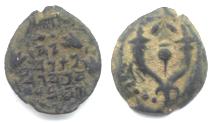
click for enlargement |
Bronze Prutah. S-6090, Meshore-12. Obverse: Hebrew inscription. Reverse: Double cornucopia with a pomegranate between them. This general type, but with variations in the obverse inscription, became a standard for coins of the Hasmonaean Dynasty for several decades. Because the inscriptions are difficult to read, these coins can very difficult to attribute to exact rulers, but we believe this one is an issue of Alexander Jannaeus. The specimen illustrated is 13 x 14 mm. |
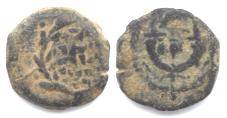
click for enlargement |
Barbarour Bronze Prutah. Obverse: Hebrew style inscription but engraved very poorly and cannot be read. Reverse: Double cornucopia with a pomegranate between them. This coin cannot be attributed by any particular Hasmonaean King, and is probably not an official mint issue. The actual size of the example illustrated is 13.4 mm. |
John Aristobulus II, 67-64 BC
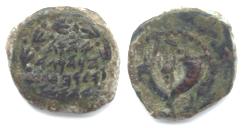
click for enlargement |
Bronze Prutah. S-6093, Meshore-28. Obverse: Hebrew inscription. Reverse: Double cornucopia with a pomegranate between them. This is a variation on the type probably first issued by Alexander Jannaeus. Because the inscriptions are difficult to read, these coins can be very difficult to attribute to exact rulers, but we believe this one is an issue of John Aristobulus II. The specimen illustrated is 14 x 15 mm. |
Mattathias Antigonos, 40 - 37 BC
In 40 BC, Judaea was ruled by John Hyrcanus II, who was subservient to Rome. Mattathias Antigonos, son of Aristobulus II, nephew of John Hyrcanus II and great-great-grandnephew of Judah Maccabee, was unhappy with this and had a claim to the throne. He enlisted the aid of the Parthian king Orodes II to invade Jerusalem and help him win the position of High Priest. In response to this Rome backed Herod as king of the Jews and aided him in a war against Mattathias. In 37 BC Mattathias was defeated and the Hasmonaean Dynasty came to an end.
 Bronze eight prutah, S-6103, Hendin-34. Obverse: double cornucopia with a Hebrew legend around. Reverse: an Ivy wreath with a Greek legend around. Actual size is 25 mm. The coins of Mattathias Antigonos are normally poorly struck and this specimen is no exception. The main elements of the design are clear, but only a few characters of the inscriptions are visible. With a mottled green and red hard patina, this is an acceptable example of this normally poor type. Bronze eight prutah, S-6103, Hendin-34. Obverse: double cornucopia with a Hebrew legend around. Reverse: an Ivy wreath with a Greek legend around. Actual size is 25 mm. The coins of Mattathias Antigonos are normally poorly struck and this specimen is no exception. The main elements of the design are clear, but only a few characters of the inscriptions are visible. With a mottled green and red hard patina, this is an acceptable example of this normally poor type.

Herodian Dynasty
With the help of the Romans, Herod the Great defeated Mattathias Antigonos in 37 BC, ending the rule of the Hasmonaean Dynasty. The power of the Herodian Dynasty was based on their ties to Rome and they ruled Judaea, including the city of Jerusalem, until 6 AD when Archelaus fell from favor and was banished. The Herodian dynasty did not end there, as Antipas and his descendants continued to rule the territories of Galilee and Perea (Jewish Transjordan), but after 6 AD Jerusalem and Judaea came under the rule of the Roman Procurators, who reported to the Roman Governor of Syria.
Herod the Great, 37-4 BC
Bronze, 18 mm. GIC-5527, Hendin-43. Obverse: an "X" surrounded by an open diadem with a Greek inscription around. Reverse: a tripod flanked by two palm branches. Normally on this issue the inscriptions are only partly legible. Fully struck examples are rare.
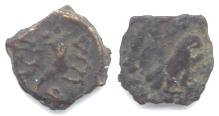
click for enlargement |
HERODIAN DYNASTY, Herod the Great. 13 mm bronze. GIC-5535. Obverse: A Greek inscription naming Herod to either side of a cornucopia. Reverse: An Eagle standing right with it's wings folded. The actual size of the specimen illustrated is 12.8 mm. A scarce and very interesting type. It was probably issued by Herod to commemorate the erection of a statue of an Eagle above the door of the Temple, something that the Jewish People of the day would have found to be very offensive. It is doubtful if this issue lasted long, or even was accepted in general circulation. |
Herod Archelaus, 4 BC - AD 6
Herod Archelaus is biblically recorded as King of Judaea at the time of Christ's birth, traditionally thought of as having occurred in AD 1. A careful reading of the bible, when correlated with other information known about the history of the period, suggests a date closer to 7 BC, when Herod the Great was King of Judaea.
The bible records that Joseph and Mary fled to Egypt upon learning that all babies under the age of two were to be killed, and returned two years later after Herod's death. If the Herod referred to was Herod Archelaus, then they returned about AD 6 and must have fled about AD 4 when Christ was 4 years old and not subject to the edict.
If we place the birth at about 7 BC, and assume Christ may have been as much as 2 years old when they fled (the bible actually says nothing about this, but why the edict that all under the age of two be killed?), then they fled about 5 B.C and returned about 3 BC, the year after Herod the Great's death, which all fits quite nicely.
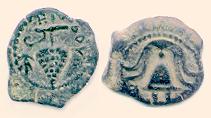 Bronze, 16 mm. GIC-5539, Meshore-61. Obverse: Cluster of grapes on a branch with Herod's name above in Greek (most letters clear). Reverse: A crested helmet with a greek inscription below (off the flan on this specimen). This is an exceptional example of the type, as most specimens are not nearly as well struck or preserved. Bronze, 16 mm. GIC-5539, Meshore-61. Obverse: Cluster of grapes on a branch with Herod's name above in Greek (most letters clear). Reverse: A crested helmet with a greek inscription below (off the flan on this specimen). This is an exceptional example of the type, as most specimens are not nearly as well struck or preserved.
Bronze, 15 mm. GIC-5541, Hendin-59. Obverse: Prow of a war galley left. Reverse: Greek letters in a wreath.
Herod Philip, 4 BC - AD 34
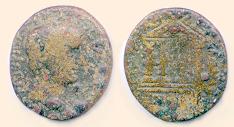 18 mm Bronze. GIC-5560-62. Meshore-80-81. Obverse: Laureate bust of Tiberius right with his name and titles around in Greek (about 50% of the legend can be read with difficulty, including most of the name). Reverse: A tetra-style temple inside of which is the regnal date (not visible on this specimen due to poor strike) with the name of Philip around (part of his name is visible below the temple). Not a thing of beauty, but these almost never are. Full legend specimens probably almost never show up. (scarce in any grade). 18 mm Bronze. GIC-5560-62. Meshore-80-81. Obverse: Laureate bust of Tiberius right with his name and titles around in Greek (about 50% of the legend can be read with difficulty, including most of the name). Reverse: A tetra-style temple inside of which is the regnal date (not visible on this specimen due to poor strike) with the name of Philip around (part of his name is visible below the temple). Not a thing of beauty, but these almost never are. Full legend specimens probably almost never show up. (scarce in any grade).
Agrippa I, AD 37-44
Agrippa was the grandson of Herod the Great and son of Aristobulus. Educated in Rome, he was favored by Caligula who granted him rule of the northern part of Judaea, and then by Claudius who gave him rule of all of Judaea. The dates on his coins are from the start of Claudius' reign.
Bronze 17 mm. GIC-5567. Obverse: A fringed Canopy. Reverse: Three ears of barley. This type was struck in year-6 (AD 42/3).

Roman Procurators
After the banishment of Herod Archelaus, Judaea was ruled by a series of Procurators appointed by Rome but who reported to the Governor of Syria. Any of the coins of the Procurators, struck before AD 32, can be considered as examples of the 'WIDOWS MITE" described in the Bible. Coins of this series tend to be poorly struck and poorly preserved. Only occasionally will a specimen be found with everything on the flan.
Coponius, AD 6 - 9
Bronze AE 17. GIC-5606. Obverse: Ear of barley with a Greek inscription around. Reverse: Palm branch with a date mark indicating this coin was struck in the 36th year of the reign of Augustus (AD 6/7). About 60% of the obverse is clear, including most of the ear of Barley.
M Ambibulus, AD 9 - 12
Bronze 17 mm. GIC-5608. Obverse: Ear of Barley with a Greek inscription around. Reverse: Palm-tree with a date mark across the trunk. The date mark is legible and is an "M" indicating this coin was struck in the 40th years of the reign of Augustus, or AD 10/11.
Valerius Gratus, AD 15 - 26
Bronze 17 mm. GIC-5615. Obverse: Greek inscription in two lines. Reverse: Three lilies between two curved leaves.
Bronze 17 mm. GIC-5620. Obverse: Three line Greek inscription naming Tiberius. Reverse: Palm-branch and date mark. The palm-branch and the date mark are clear on this specimen. The letter "E" in the fields indicates regnal year-5 (AD18/19).
Pontius Pilate, AD 26 - 36
Pontius Pilate ruled Judaea during the Ministry of Christ and ordered his crucifixion. These coins are the type that would have been in common everyday use at the time. Note that the images are somewhat enlarged.
 Bronze 17 mm. GIC-5623. Obverse: a lituus (astrologer's staff) within an inscription. Reverse: date mark in a wreath (LIZ for AD 30/31). The specimen illustrated is far above average for this normally very poorly struck type. Often these are seen in specimens with only fragmentary designs. Bronze 17 mm. GIC-5623. Obverse: a lituus (astrologer's staff) within an inscription. Reverse: date mark in a wreath (LIZ for AD 30/31). The specimen illustrated is far above average for this normally very poorly struck type. Often these are seen in specimens with only fragmentary designs.
 Bronze 17 mm. GIC-5624. Obverse: a lituus (astrologer's staff) within an inscription. Reverse: date mark in a wreath with the date mark LIH, indicates this coin was struck in AD 31/32. This specimen is far above average for this usually normally poorly struck type. Bronze 17 mm. GIC-5624. Obverse: a lituus (astrologer's staff) within an inscription. Reverse: date mark in a wreath with the date mark LIH, indicates this coin was struck in AD 31/32. This specimen is far above average for this usually normally poorly struck type.
Antonius Felix, AD 52 - 60
It was Antonius Felix that presided at St. Paul's trial.
Bronze 17 mm. GIC-5625. Obverse: a four-line Greek inscription in a wreath. Reverse: Two crossed palm-branches with a date mark for year 14 of Claudius (AD 54) between.

click for enlargement |
Bronze 16.5 mm. GIC-5627. Obverse: A palm branch flanked by a Greek inscription giving the date (Year-5 of Nero, AD 58/9). Reverse: A three line Greek inscription naming Nero, all within a wreath. |

The First Revolt, AD 66-70
Unhappy with the rule of the Roman Procurators, the Judaeans rose up in open revolt in AD 66. The revolt withstood the Romans for several years (not a small thing), but in AD 70 Titus (son of Vespasian and himself future emperor) was sent to put and end to it. Jerusalem was sacked and the Temple was destroyed. During this period, the Jewish people struck a number of types of coins, and afterwards, the Romans struck the Judea Capta series to commemorate their victory.
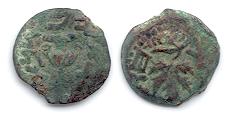 AE 18, GIC-5639. Obverse: A narrow-necked amphora surrounded by a Hebrew legend that translates to "YEAR 2", indicating that this type was struck in the 2nd years of the revolt (AD 67). Reverse: A Vine-branch with a single leaf, surrounded by a Hebrew legend that translates to "THE FREEDOM OF ZION". These coins average 16 to 17 mm. AE 18, GIC-5639. Obverse: A narrow-necked amphora surrounded by a Hebrew legend that translates to "YEAR 2", indicating that this type was struck in the 2nd years of the revolt (AD 67). Reverse: A Vine-branch with a single leaf, surrounded by a Hebrew legend that translates to "THE FREEDOM OF ZION". These coins average 16 to 17 mm.
21 mm bronze. GIC- 5646, Meshore-163. Obverse: A Chalice around which occurs the Hebrew legend translating to "TO THE REDEMPTION OF ZION". Reverse: A Lulav (looks like a basket of grain stalks) flanked by two etrog (look like two small amphora) and with inscriptions indicating it was struck in the 4th year of the revolt (AD 69/70).

The Second Revolt (Bar Cochba War), AD 132 - 135
During the reign of Hadrian, the Romans prohibited circumcision and decided to found a Roman city on the site of Jerusalem. As could be expected, the Judaeans found this to be offensive and, led by Shim'on Ben Cosiba, revolted against Roman authority. After a bitter three-year war, the Judaeans were finally defeated.
To finance the war, the forces of Shim'on Ben Cosiba minted coins consisting of Silver tetradrachms, denarii and assorted bronzes. Due to a shortage of metal, probably a shortage of time, and possibly as an affront to the Romans, the silver coins were usually overstruck on earlier Roman coins.
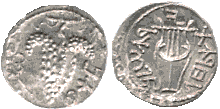
click for enlargement |
Silver denarius, GIC-5668. Obverse: A bunch of grapes with a Hebrew legend around. Reverse: A Lyre with the Hebrew legend "FOR THE FREEDOM OF JERUSALEM" around. It is fairly common for these to be struck over Roman denarius, but this coin has a special feature: it is very clearly struck over a denarius of the Roman Emperor Titus, with the partial inscription (T)"ITUS CAES" clearly visible at the 8 o'clock position on the reverse, and "S VII PP" at the nine o'clock position on the obverse (indicating a coin struck in AD 79). That Titus was responsible for the destruction of the temple in the First Revolt, and then his effigy was defaced on this coin to help finance the Second Revolt, makes this a very interesting specimen. These coins are normally found fairly well struck. Actual size is 18 mm. |

City Coins of the Holy Land
JUDAEA, ASCALON, 21 mm bronze of Hadrian, AD 117-138. GIC-1250. Obverse: Bust of Hadrian right. Reverse: City goddess standing slightly left. This series is normally found in a very poor state of preservation.
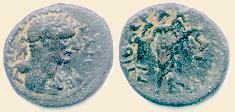 GALILAEA, TIBERIAS, 18 mm bronze. Obverse: bust of Hadrian right. Reverse: standing figure of Victory. At this time Tiberias was an important city, according to Jewish history. Far above average for this typically very crude series of coins. GALILAEA, TIBERIAS, 18 mm bronze. Obverse: bust of Hadrian right. Reverse: standing figure of Victory. At this time Tiberias was an important city, according to Jewish history. Far above average for this typically very crude series of coins.

Roman Republican Coins Relating to Judaea
 A. PLAUTIUS, silver denarius, 55 BC, S-304, RSC Plautia #13. Obverse: Turreted head of Cybele facing right with "A PLAVTIVS" in front. The inscription, which would read "AED CUR S C" behind the head is off the flan. Reverse: A male figure (Bacchius ?) kneeling beside a camel facing right, with "BACCHIUS" below and "JVDAEVS" before. 17 mm. These coins generally come fairly well struck. A. PLAUTIUS, silver denarius, 55 BC, S-304, RSC Plautia #13. Obverse: Turreted head of Cybele facing right with "A PLAVTIVS" in front. The inscription, which would read "AED CUR S C" behind the head is off the flan. Reverse: A male figure (Bacchius ?) kneeling beside a camel facing right, with "BACCHIUS" below and "JVDAEVS" before. 17 mm. These coins generally come fairly well struck.
Plautius was a commander in Pompey's army when Aristobulus II was captured by Pompey following the seige of Jerusalem in 63 BC. The identity of Bacchius is uncertain, as there is no record of him except for this coin type, but the reference to the subjugation of Judaea is clear and it is possible that Bacchius refers to Aristobulus II.

Roman Imperial Coins Relating to Judaea
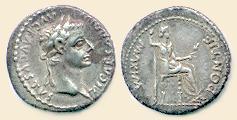 Tiberius. AD 14-37, Silver denarius, S-567. Obverse: bust of Tiberius right with "TI CAESAR DIVI AUG F AUGUSTUS" around. Reverse: Livia seated left with "PONTIF MAXIM" around. Very nice for one of these, with only the tops of a few letters off the flan on the obverse. The dark spot in front of the mouth is not as dark on the coin as it looks on the image. The specimen illustrated is somewhat better centered than is normal for this issue. On a typical specimen only about half of the reverse legend will be visible. This is the famous "Tribute Penny" of the Bible. Tiberius. AD 14-37, Silver denarius, S-567. Obverse: bust of Tiberius right with "TI CAESAR DIVI AUG F AUGUSTUS" around. Reverse: Livia seated left with "PONTIF MAXIM" around. Very nice for one of these, with only the tops of a few letters off the flan on the obverse. The dark spot in front of the mouth is not as dark on the coin as it looks on the image. The specimen illustrated is somewhat better centered than is normal for this issue. On a typical specimen only about half of the reverse legend will be visible. This is the famous "Tribute Penny" of the Bible.
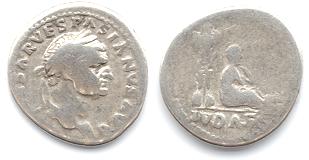 Silver denarius, S-777. Obverse: bust of Vespasian right, with "(IMP CA) ESAR VESPASIANVS AVG" around (the first part of the legend is off the flan). Reverse: Jewess in an attitude of mourning, seated right before a military trophy, with "IVDAEA" below. The reverse is nicely centered and while somewhat worn, is still clear. 18.5 mm. Silver denarius, S-777. Obverse: bust of Vespasian right, with "(IMP CA) ESAR VESPASIANVS AVG" around (the first part of the legend is off the flan). Reverse: Jewess in an attitude of mourning, seated right before a military trophy, with "IVDAEA" below. The reverse is nicely centered and while somewhat worn, is still clear. 18.5 mm.
This type was first struck in AD 70 to commemorate the defeat of the Jewish revolt, and is part of what is commonly known as the Judaea Capta series.
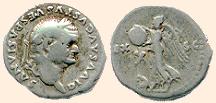 VESPASIAN, commemorative struck by Titus in AD 79, Silver denarius, RSC-144. Obverse: bust of Vespasian right with "DIVVS AVGVSTVS VESPASIANVS" around. Reverse: Victory standing left, erecting a trophy at the foot of which is seated a captive, with "EX SC" either side of the trophy. The obverse clearly commemorates the deification of Vespasian. The meaning of the reverse is less clear, but most references refer to the captive as a Jew, and place this as part of the Judaea Capta series (Hendin #212). Since Judaea was the most important victory during his reign, this is the most likely explanation even though there is nothing to identify the captive as a Judaean. He had several other victories and the design may be a general reference to all his victories. VESPASIAN, commemorative struck by Titus in AD 79, Silver denarius, RSC-144. Obverse: bust of Vespasian right with "DIVVS AVGVSTVS VESPASIANVS" around. Reverse: Victory standing left, erecting a trophy at the foot of which is seated a captive, with "EX SC" either side of the trophy. The obverse clearly commemorates the deification of Vespasian. The meaning of the reverse is less clear, but most references refer to the captive as a Jew, and place this as part of the Judaea Capta series (Hendin #212). Since Judaea was the most important victory during his reign, this is the most likely explanation even though there is nothing to identify the captive as a Judaean. He had several other victories and the design may be a general reference to all his victories.
|



